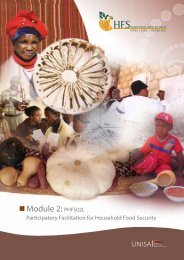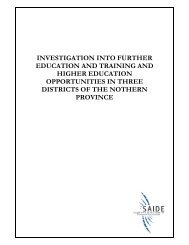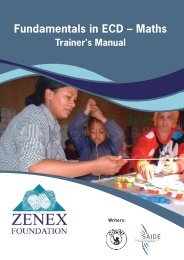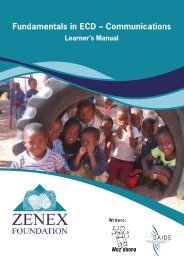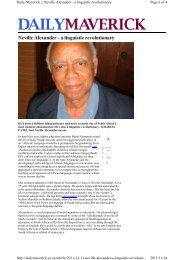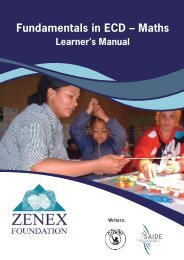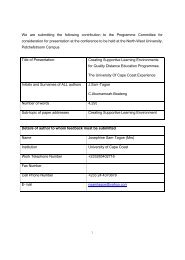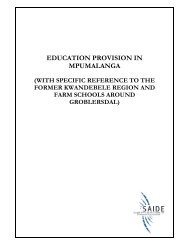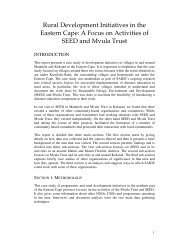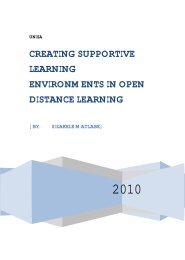Creating a supportive learning environment for the ACE school ...
Creating a supportive learning environment for the ACE school ...
Creating a supportive learning environment for the ACE school ...
- No tags were found...
You also want an ePaper? Increase the reach of your titles
YUMPU automatically turns print PDFs into web optimized ePapers that Google loves.
<strong>Creating</strong> a <strong>supportive</strong> <strong>learning</strong> <strong>environment</strong> <strong>ACE</strong> SL University of Pretoria1<br />
<strong>Creating</strong> a <strong>supportive</strong> <strong>learning</strong> <strong>environment</strong> <strong>for</strong> <strong>the</strong> <strong>ACE</strong> <strong>school</strong> leadership<br />
programme at <strong>the</strong> University of Pretoria<br />
Dr Keshni Bipath<br />
Department of Education Management and Policy studies<br />
(University of Pretoria)<br />
keshni.bipath@up.ac.za
<strong>Creating</strong> a <strong>supportive</strong> <strong>learning</strong> <strong>environment</strong> <strong>ACE</strong> SL University of Pretoria2<br />
Abstract<br />
This paper claims that <strong>the</strong> most essential ingredients in <strong>the</strong> quest <strong>for</strong> success in<br />
<strong>the</strong> <strong>ACE</strong> School Leadership Programme at <strong>the</strong> University of Pretoria is a product<br />
of (ex-retired <strong>school</strong> principals + enthusiastic lecturers + motivated students ) X<br />
(mentorship preparation + trust + stages in relationships + teamwork + <strong>school</strong><br />
visits + portfolios).The participants in <strong>the</strong> programme are principals (mentees)<br />
from 50 Mpumalanga <strong>school</strong>s in <strong>the</strong>ir first year of study and 10 retired principals<br />
(mentors). Respondents completed a survey which consisted of thirteen open<br />
ended questions on <strong>the</strong>ir experiences of being a mentor or mentee. In addition,<br />
respondents were asked about <strong>the</strong> extent to which <strong>the</strong> mentor interaction during<br />
site visits improved <strong>the</strong>ir self development, professional development and<br />
institutional development during in<strong>for</strong>mal interviews. Fur<strong>the</strong>rmore, 3 <strong>school</strong>s were<br />
visited and observations were used <strong>for</strong> crystallization purposes. Results of <strong>the</strong><br />
study claim that <strong>the</strong> success of <strong>the</strong> <strong>ACE</strong> <strong>school</strong> Leadership programme at <strong>the</strong><br />
University of Pretoria was <strong>the</strong> result of blending <strong>the</strong> right people toge<strong>the</strong>r and<br />
multiplying <strong>the</strong>m with understanding <strong>the</strong> dimensions of trust in relationship<br />
building, acknowledging <strong>the</strong> stages of development in relationships, prepreparation<br />
on <strong>the</strong> role and tasks of <strong>the</strong> mentors and working toge<strong>the</strong>r with a<br />
positive synergy towards excellence. Implications <strong>for</strong> successful practice in this<br />
programme resulted in provincial departments providing more students <strong>for</strong><br />
enrolment in this fabulous programme.
<strong>Creating</strong> a <strong>supportive</strong> <strong>learning</strong> <strong>environment</strong> <strong>ACE</strong> SL University of Pretoria3<br />
Over <strong>the</strong> past few years mentoring and coaching have become familiar buzz<br />
words in industry. What exactly is <strong>the</strong> difference between a coach and a mentor<br />
Everson says that coaching is a one-on-one relationship with someone who is in<br />
your corner. They don't fix <strong>the</strong> problem or give direct advice but <strong>the</strong>y can give you<br />
a new perspective on how to look at <strong>the</strong> problem, help you see outside your box.<br />
The role of a mentor is slightly different. "The mentor is someone who offers<br />
direct advice and guidance because <strong>the</strong> mentee values <strong>the</strong>ir experience, wisdom<br />
and life stories and many companies are seeing <strong>the</strong> value of both approaches,"<br />
says Everson.<br />
Browne-Ferrigno and Muth (2006, 290) claim that retired principals are better<br />
mentors because <strong>the</strong>y “are not burdened with responsibilities of <strong>school</strong><br />
leadership, <strong>the</strong>y have more time to provide immediate advice and feedback when<br />
needed by principals. Retired principals have completed significant service over<br />
many years, <strong>the</strong>y can provide historical perspectives and share tacit knowledge<br />
with new entrants to <strong>the</strong> principalship, …”. Browne-Ferrigno and Muth’s study<br />
proved that readiness to assume a principalship appears to be linked to an<br />
individuals encouragement and support from leadership mentors, opportunities to<br />
engage in au<strong>the</strong>ntic leadership activities and perceptions of personal<br />
competence to assume <strong>school</strong> leadership responsibilities (2006, 275). The<br />
University of Pretoria hired retired principals of excellent <strong>school</strong>s to mentor<br />
principals <strong>for</strong> quality enhancement and problem solving skills.<br />
However, due to <strong>the</strong> previous apar<strong>the</strong>id era, <strong>the</strong>se excellent ex-principals who<br />
were chosen to mentor were from <strong>the</strong> ex-Transvaal Education System (TED) and<br />
<strong>the</strong> principals in <strong>the</strong> programme were from rural, disadvantaged <strong>school</strong>s. The<br />
principals were young Black females and males and <strong>the</strong> mentors were elderly<br />
White males. Tony Bush, in a paper delivered at <strong>the</strong> AEASA conference in<br />
Pretoria on <strong>the</strong> 8 th August 2009 also emphasized <strong>the</strong> mismatch between <strong>the</strong>
<strong>Creating</strong> a <strong>supportive</strong> <strong>learning</strong> <strong>environment</strong> <strong>ACE</strong> SL University of Pretoria4<br />
mentors and mentees in <strong>the</strong> <strong>ACE</strong> SL programme used by <strong>the</strong> University of<br />
Pretoria. In a report from Zennex (2008), one of <strong>the</strong> researchers observed <strong>the</strong><br />
body language between <strong>the</strong> mentors and mentees on <strong>the</strong> first orientation day.<br />
The mentees sat in <strong>the</strong> back of <strong>the</strong> lecture room, behind <strong>the</strong> mentees. A problem<br />
was <strong>for</strong>seen but was this going to hinder <strong>the</strong> development of principal trainees<br />
Rationale and Aim<br />
During <strong>the</strong> 6 th International Symposium of Educational Re<strong>for</strong>m (ISER) held in<br />
Mpumalanga on <strong>the</strong> 26 th to 28 th July 2010, <strong>the</strong> top students of <strong>the</strong> first and<br />
second cohort were acknowledged <strong>for</strong> <strong>the</strong>ir achievements. All of <strong>the</strong> students<br />
showed a positive self development and professional development. Their<br />
<strong>school</strong>s were visited by <strong>the</strong> ISER delegates to observe <strong>the</strong> relationship between<br />
<strong>the</strong> institutional development and professional development. The observations<br />
showed tremendous improvement in <strong>the</strong> management and leadership of <strong>school</strong>s.<br />
Visionary leadership was observed by <strong>the</strong> constant reference to <strong>the</strong> vision and<br />
mission statement by <strong>the</strong> leader, classrooms were well set up with charts and<br />
learners’ outstanding work on display, learners were busy with work and had<br />
learners’ books and textbooks on <strong>the</strong>ir desk, discipline was maintained although<br />
some classes had over 70 learners seated and <strong>the</strong> pleasant surroundings and<br />
teaching and <strong>learning</strong> climate was thrilling <strong>for</strong> me as a lecturer. Had<br />
Mpumalanga <strong>school</strong>s been turned around due a <strong>school</strong> leadership programme<br />
Did <strong>the</strong> leader’s trans<strong>for</strong>mation during <strong>the</strong> programme lead to <strong>the</strong> trans<strong>for</strong>mation<br />
of <strong>the</strong> whole <strong>school</strong> One thing was clear, <strong>the</strong> rural <strong>school</strong>s in Mpumalanga were<br />
operating like well-resourced private <strong>school</strong>s in an urban areas in Gauteng.<br />
The aim of <strong>the</strong> paper was to explore <strong>the</strong> factors that led to <strong>the</strong> successful<br />
creation of a <strong>learning</strong> <strong>environment</strong> <strong>for</strong> students in <strong>the</strong> <strong>ACE</strong> School Leadership<br />
programme. The students were making a difference to <strong>the</strong>ir institutions.<br />
Certainly, <strong>the</strong>re was a combination of ingredients that led to <strong>the</strong> visible and<br />
exciting changes observed.
<strong>Creating</strong> a <strong>supportive</strong> <strong>learning</strong> <strong>environment</strong> <strong>ACE</strong> SL University of Pretoria5<br />
Research Methodology<br />
This study used a multi-method strategy (Creswell, 2003) and drew on data<br />
collected originally <strong>for</strong> o<strong>the</strong>r purposes (Kiecolt & Nathan, 1985; Tashakkori &<br />
Teddlie, 1998). Survey research was used as a method of collecting in<strong>for</strong>mation<br />
by asking a set of pre<strong>for</strong>mulated questions in a predetermined sequence in a<br />
structured questionnaire to a sample a sample of individuals drawn so as to be<br />
representative of a defined population.The sample consisted of 50 participating<br />
principals in <strong>the</strong>ir first year of study and <strong>the</strong>ir 9 mentors (retired principals). The<br />
survey consisted of 13 questions. Member checking was carried out during <strong>the</strong><br />
lectures and unstructured interviews during <strong>the</strong> in<strong>for</strong>mal lunch 17 November<br />
2009. A prize-giving event was arranged in Mpumalanga where <strong>the</strong> top 5<br />
students were acknowledged. During this event, presentations were made by<br />
top students and <strong>the</strong>ir <strong>school</strong>s were visited by <strong>the</strong> lecturers to observe whe<strong>the</strong>r<br />
professional improvement and institutional improvement occurred.<br />
The surveys, interviews and powerpoint presentations by top learners during <strong>the</strong><br />
ISER (2010) were analysed through <strong>the</strong> use of discourse analysis. Discourse<br />
analysis is thus concerned with studying and analyzing written texts and spoken<br />
words to reveal <strong>the</strong> discursive sources of power, dominance, inequality and bias,<br />
and how <strong>the</strong>se sources are initiated, maintained, reproduced and trans<strong>for</strong>med<br />
within specific social, economic, political and historical contexts. (Niewenhuis,<br />
2007,102).<br />
Participants and Setting<br />
Participants are transported to <strong>the</strong> campus over a period of two years <strong>for</strong> 20<br />
monthly lecture and facilitation sessions. Six hour contact time with participants<br />
consists of 3 hours lectures and 3 hours facilitation with mentors. Lecturers<br />
teach <strong>the</strong> <strong>the</strong>oretical aspect of <strong>school</strong> leadership and mentors are assigned to 6
<strong>Creating</strong> a <strong>supportive</strong> <strong>learning</strong> <strong>environment</strong> <strong>ACE</strong> SL University of Pretoria6<br />
to 8 principals in order to facilitate, guide, direct and assist in <strong>the</strong> change that<br />
needs to be implemented in institutional development (<strong>school</strong>s) and selfdevelopment<br />
(principals). Schools were also visited by <strong>the</strong>se mentors who<br />
supported and guided students in strategies <strong>for</strong> <strong>school</strong> improvement. The<br />
university has utilized <strong>the</strong> services of retired <strong>school</strong> principals as partners in <strong>the</strong><br />
mentorship of <strong>the</strong>ir students who are mainly newly elected principals in <strong>school</strong>s in<br />
Mpumalanga. These mentors that were selected were ex-principals who had<br />
good track records of being functional <strong>school</strong> principals. The mentors were<br />
generally elderly White Afrikaner males and <strong>the</strong> mentees were young Black<br />
males and females. A qualitative research approach was conducted whereby 50<br />
first year students and 10 mentors were requested to complete a series of<br />
questions examining <strong>the</strong>ir experiences during <strong>the</strong> mentor-mentee partnership.<br />
Fu<strong>the</strong>rmore, mentees and mentors were interviewed in<strong>for</strong>mally on <strong>the</strong> findings of<br />
<strong>the</strong>se surveys. The top 5 students of each of <strong>the</strong> first two cohorts were<br />
requested to present PowerPoint presentations of <strong>the</strong>ir experiences during <strong>the</strong> 2<br />
years and how this has impacted on <strong>the</strong> progress of <strong>the</strong>ir <strong>school</strong>s.<br />
Literature Study<br />
Jansen (2008) states that <strong>the</strong> answer to “<strong>the</strong> restoration of productive <strong>school</strong><br />
cultures might lie in white Afrikaans <strong>school</strong>s. If you take a walk through a white<br />
Afrikaans high <strong>school</strong>, you will notice that <strong>the</strong> teachers do not walk: <strong>the</strong>y’re half<br />
running, a draf-stappie in <strong>the</strong> native language. The body language of every<br />
teacher suggests that he or she needs to be somewhere else, teaching and<br />
taking care of children. To walk is to suggest being casual, unconcerned. It is an<br />
inconvenient truth, not palatable to black nationalist sentiment, that <strong>the</strong> answers<br />
to <strong>the</strong> restoration of productive <strong>school</strong> cultures might lie in <strong>the</strong>se white Afrikaans<br />
<strong>school</strong>s. South Africans are understandably cautious about <strong>the</strong> word ‘culture’. It<br />
was, after all, a word that was substituted, all too readily, <strong>for</strong> <strong>the</strong> more
<strong>Creating</strong> a <strong>supportive</strong> <strong>learning</strong> <strong>environment</strong> <strong>ACE</strong> SL University of Pretoria7<br />
uncom<strong>for</strong>table word ‘race’. But <strong>school</strong>s have a culture it is a collection of<br />
attitudes, values and behaviours that defines and distinguishes productive<br />
<strong>school</strong>s. The reason <strong>the</strong> academic results of <strong>the</strong> Afrikaans <strong>school</strong>s are, on<br />
average, much higher than those of <strong>the</strong>ir counterparts is not only because of <strong>the</strong>ir<br />
relatively privileged position with respect to resource”.<br />
Whilst <strong>the</strong> nature of <strong>the</strong> relationship is often hierarchical in that <strong>the</strong> two partners<br />
differ in status, power, knowledge, and experience in terms of <strong>the</strong>ir professional<br />
standing (Clutterbuck & Megginson, 1999), this is not always <strong>the</strong> case. Mentors<br />
in modern organizations are increasingly likely to be equal in status to <strong>the</strong><br />
mentees, and ‘serve as both teachers and learners in a relationship based on<br />
shared purpose, co-inquiry, respect and trust’ (Fritts, 1998, p. 3). Whatever <strong>the</strong><br />
nature of <strong>the</strong> mentor–mentee relationship, what is important is that <strong>the</strong> mentor<br />
takes on <strong>the</strong> role of a partner who works alongside <strong>the</strong> mentee in order to foster<br />
<strong>learning</strong> and development, and in a variety of different ways. Baird (1993)<br />
describes this role as ‘a solid amalgam of Helper + Sharer + Carer’ (p. 55) while<br />
Crow and Mat<strong>the</strong>ws (1998) view <strong>the</strong> mentee as traveller and <strong>the</strong> mentor as<br />
guide. Because of <strong>the</strong> highly developmental and reflective emphasis of<br />
mentoring, it is essential that it takes place in such a way that trust underpins <strong>the</strong><br />
relationship between mentor and mentee, and that a safe psychological and<br />
emotional <strong>environment</strong> is provided (Carru<strong>the</strong>rs, 1993; Bolam et al., 1995). As<br />
Rymer (2002) states: ‘The core of mentoring is a close, developmental<br />
relationship based on mutual trust’ (p. 344). If a mentee is to flourish within this<br />
relationship, notions of confidentiality, support, openness, and collegiality must<br />
be evident in <strong>the</strong> mentoring process. Fur<strong>the</strong>rmore, issues of individual position<br />
and power differences should not enter this partnership. Ra<strong>the</strong>r, a mentor should<br />
be a sensitive and trusted advisor who accepts <strong>the</strong> mentee’s stage of<br />
development and provides a safe <strong>environment</strong> in which <strong>learning</strong> and<br />
development may occur (Clutterbuck, 1998; Bell, 2000).
<strong>Creating</strong> a <strong>supportive</strong> <strong>learning</strong> <strong>environment</strong> <strong>ACE</strong> SL University of Pretoria8<br />
The stages of development in relationships<br />
UP <strong>ACE</strong> SL Roadmap<br />
Implementation Roadmap<br />
Year 0<br />
Leadership<br />
and<br />
Management<br />
Lead and manage<br />
people<br />
Year 2<br />
Forming<br />
Storming<br />
Management of <strong>the</strong><br />
curriculum<br />
Managing educational<br />
resources<br />
Education Law and<br />
Governance<br />
Modules taught over 2 years<br />
Research project<br />
Norming<br />
Per<strong>for</strong>ming<br />
Stages in partnership development<br />
Adjourning<br />
22
<strong>Creating</strong> a <strong>supportive</strong> <strong>learning</strong> <strong>environment</strong> <strong>ACE</strong> SL University of Pretoria9<br />
Relationship stages<br />
Implementation Roadmap<br />
Year 0<br />
Formal stage<br />
Year 2<br />
Forming<br />
Cautious stage<br />
Storming<br />
Sharing stage<br />
Norming<br />
Open stage<br />
Per<strong>for</strong>ming<br />
Beyond stage<br />
Adjourning<br />
Relationship stages<br />
Stages in partnership development<br />
25<br />
Assignment preparation and <strong>school</strong> visits<br />
Implementation Roadmap<br />
Year 0<br />
Formal stage<br />
Year 2<br />
Orientation<br />
Cautious stage<br />
Facilitation<br />
sessions<br />
Sharing stage<br />
School<br />
visits<br />
Relationship stages<br />
Open stage<br />
Beyond stage<br />
Assignment<br />
preparation<br />
Stages in partnership development<br />
Handing in<br />
portfolios<br />
26
<strong>Creating</strong> a <strong>supportive</strong> <strong>learning</strong> <strong>environment</strong> <strong>ACE</strong> SL University of Pretoria10<br />
Trust dimensions<br />
Integrity refers to honesty and truthfulness. Competence encompasses an<br />
individual’s technical and interpersonal knowledge and skills. Consistency relates<br />
to an individuals reliability, predictability and good judgment in handling<br />
situations. Inconsistencies between words and action decrease trust. Nothing is<br />
noticed more quickly …than a discrepancy between what executives preach and<br />
what <strong>the</strong>y expect <strong>the</strong>ir associates to practice. Loyalty is <strong>the</strong> willingness to protect<br />
and save face <strong>for</strong> ano<strong>the</strong>r person. Trust requires that you can depend on<br />
someone not to act opportunistically. The final dimension of trust is openness.<br />
Can you rely on <strong>the</strong> person who gave you <strong>the</strong> full truth.<br />
Dimensions of trust<br />
Implementation Roadmap<br />
Year 0<br />
Integrity<br />
Year 2<br />
Forming<br />
Competence<br />
Storming<br />
Consistency<br />
Norming<br />
Loyalty<br />
Per<strong>for</strong>ming<br />
Openess<br />
Adjourning<br />
Dimensions of trust<br />
Stages in partnership development<br />
24<br />
Pre-preparation on <strong>the</strong> role and tasks of <strong>the</strong> mentors<br />
The role of <strong>the</strong> mentor can be described as in <strong>the</strong> table below and mentors are<br />
trained in <strong>the</strong> beginning of <strong>the</strong> year regarding <strong>the</strong>ir role and tasks. The following<br />
table describes briefly <strong>the</strong> main points covered during <strong>the</strong> training of mentors in
<strong>Creating</strong> a <strong>supportive</strong> <strong>learning</strong> <strong>environment</strong> <strong>ACE</strong> SL University of Pretoria11<br />
order to enhance <strong>the</strong> <strong>supportive</strong> <strong>environment</strong> created <strong>for</strong> <strong>the</strong> students to per<strong>for</strong>m.<br />
Mentors faciliatated after <strong>the</strong> lecture sessions and were <strong>the</strong>n required to visit <strong>the</strong><br />
principals in <strong>the</strong>ir <strong>school</strong>s to assess, guide and assist in positive institutional<br />
development. Three two-hour visits were done per semester over <strong>the</strong> two year<br />
visit. The findings show that perhaps this was <strong>the</strong> largest dose of ingredient that<br />
led to <strong>the</strong> success of implementation of <strong>the</strong>ory into practical action plans. The<br />
mentors attended all lectures and toge<strong>the</strong>r with <strong>the</strong>ir experience, found it<br />
“wonderful” and “fulfilling” to assist <strong>the</strong>ir mentees. Fur<strong>the</strong>rmore, <strong>the</strong>y were<br />
astounded and horrified by <strong>the</strong> lack of resources in <strong>the</strong>se <strong>school</strong>s and realized<br />
that <strong>the</strong> task that <strong>the</strong>ir mentees had to accomplish were ridden with challenges.<br />
They were prepared to face <strong>the</strong> challenges and even went to <strong>the</strong> point of writing<br />
to <strong>the</strong> department of education and applying <strong>for</strong> sponsorships to achieve <strong>the</strong><br />
visions of <strong>the</strong> <strong>school</strong>s. The mentees regarded <strong>the</strong>ir mentors as “fa<strong>the</strong>rs” and this<br />
captured <strong>the</strong> relationship that was <strong>for</strong>med.<br />
Table: The role and tasks of mentors<br />
A mentor is a/n…<br />
A mentor…<br />
Advisor<br />
Asks questions<br />
Catalyst/enabler<br />
Challenges productively<br />
Critical friend<br />
Encourages risk-taking<br />
Guide<br />
Helps identify goals<br />
Listener<br />
Listens actively<br />
Role model<br />
Offers encouragement<br />
Sounding board<br />
Promotes independence<br />
Strategist<br />
Provides feedback<br />
Supporter<br />
Share critical knowledge<br />
Tactician/• Teacher<br />
Working toge<strong>the</strong>r with a positive synergy towards excellence
<strong>Creating</strong> a <strong>supportive</strong> <strong>learning</strong> <strong>environment</strong> <strong>ACE</strong> SL University of Pretoria12<br />
The lecturers in <strong>the</strong> programme were experienced and enthusiastic and <strong>the</strong>y are<br />
all module coordinators in <strong>the</strong> Distance Education programmes that <strong>the</strong> university<br />
offers. This confidence that <strong>the</strong>y would be able to deliver a good promme,<br />
toge<strong>the</strong>r with <strong>the</strong> choice of excellent mentors was <strong>the</strong> first mixture <strong>for</strong> success.<br />
Fortunately, <strong>the</strong> participants were excited about being on a university premise <strong>for</strong><br />
<strong>the</strong> first time in <strong>the</strong>ir lives and <strong>the</strong>y were eager to listen and learn. The people<br />
worked with a positive synergy towards excellence.<br />
Conclusion<br />
The fact that all <strong>the</strong> top students mentioned that <strong>the</strong> programme had positively<br />
impacted on <strong>the</strong>ir self, professional and institutional development was evidence<br />
of <strong>the</strong> equation that is claimed by <strong>the</strong> paper is proved to be true. Mpumalanga<br />
Department of education is eager to train all <strong>the</strong>ir principals in <strong>the</strong> <strong>ACE</strong> School<br />
Leadership as soon as possible but due to <strong>the</strong> quality of <strong>the</strong> programme, <strong>the</strong><br />
university accepts 60 principals at a time <strong>for</strong> training. Mentors are assigned to 5<br />
mentees and lectures are interactionally delivered. Students are now been<br />
lectured to in venues in Nelspruit to avoid <strong>the</strong> long journeys and causal tiredness<br />
and lecturers find that <strong>the</strong> students are more alert and eager to ask questions<br />
and discuss situational issues. This recipe might not be a perfect fit <strong>for</strong> all<br />
institutions but at <strong>the</strong> University of Pretoria, <strong>ACE</strong> School Leadership = ƒ(exretired<br />
<strong>school</strong> principals + enthusiastic lecturers + motivated students ) X<br />
(mentorship preparation + trust + stages in relationships + teamwork + <strong>school</strong><br />
visits + portfolios).<br />
Bibliography<br />
Ambrose, L. 1998. A mentor’s companion. Chicago: Perrone-Ambrose.<br />
Bell, C. 2000. The mentor as partner, Training and Development (February) : 52–56.<br />
Boice, R. 1992. The new faculty member. San Francisco: CA, Jossey-Bass.
<strong>Creating</strong> a <strong>supportive</strong> <strong>learning</strong> <strong>environment</strong> <strong>ACE</strong> SL University of Pretoria13<br />
Bowman, S. R., Kite, M. E., Branscombe, N. R. and Williams, S. 1999. Developmental<br />
relationships of Black Americans in <strong>the</strong> academy, in: A. J. Murrell, F. J. Crosby and R. J.<br />
Ely. eds. Mentoring dilemmas: developmental relationships within multicultural<br />
organizations. Mahwah, NJ: Lawrence Erlbaum Associates: 21–46.<br />
Brinson, J. and Kottler, J. 1993. Cross-cultural mentoring in counselor education: a strategy<br />
<strong>for</strong><br />
retaining minority faculty. Counselor Education and Supervision 32(4): 241–253.<br />
Browne-Ferrigno, T. and Muth, R. 2004. Leadership mentoring in clinical practice: role<br />
socialisation, professional development and capacity building. Education Administration<br />
Quarterly 40: 468-494.<br />
Browne-Ferrigno, T. and R. Muth. 2006. Leadership mentoring and situated <strong>learning</strong>:<br />
catalysts <strong>for</strong> principalship readiness and lifelong mentoring. 14 (3): 275-295.<br />
Browne-Ferrigno, T. 2005. Sometimes <strong>the</strong>y’re simply not ready <strong>for</strong> <strong>the</strong> principalship:<br />
outcomes of intensive post-certification professional development. Paper presented at <strong>the</strong><br />
annual conference of <strong>the</strong> National Council <strong>for</strong> Professors of Educational Adminitration,<br />
Washington, DC, July<br />
Bush, T. 2008. AMASA conference in Pretoria on <strong>the</strong> 8 th August 2009.<br />
Bush, T, N Duku, D. Glover, E. Kiggundu, S. Kola, V.Msila and P. Moorosi. 2007. The Zenex<br />
<strong>ACE</strong>: School Leadership Research First Interim Report.<br />
Carru<strong>the</strong>rs, J. 1993. The principles and practice of mentoring. in: B. Caldwell and E. Carter.<br />
eds. The return of <strong>the</strong> mentor: strategies <strong>for</strong> workplace <strong>learning</strong>. London: Falmer Press.<br />
Clutterbuck, D. and Megginson, D. 1999. Mentoring executives and directors. Ox<strong>for</strong>d:<br />
Butterworth-Heinemann.
<strong>Creating</strong> a <strong>supportive</strong> <strong>learning</strong> <strong>environment</strong> <strong>ACE</strong> SL University of Pretoria14<br />
Crow G. and Mat<strong>the</strong>ws, L. J. 1998. Finding one’s way: how mentoring can lead to dynamic<br />
leadership. Newbury Park, CA: Corwin Press.<br />
Daresh, J. C. 1995: Research base on mentoring <strong>for</strong> educational leaders: what do we know<br />
Journal of Educational Administration 33(5): 7-16.<br />
Daresh, J. C. and Playko, M. A. 1990. Mentor programs: focus on <strong>the</strong> beginning principal,<br />
NASSP Bulletin 74(529): 73-77.<br />
Daresh, J. C. and Playko, M. A. 1995. The arrival of <strong>the</strong> new principal: reactions of staff,<br />
Change 3(3): 322-333.<br />
Daresh, J. and Playko, M. "Teacher Mentors and Administrative Mentors: Same Track,<br />
Different Trains". Planning and Changing. 20 (2): 88-96.<br />
Hansen, J. M. and Mat<strong>the</strong>ws, J. 2002.The power of more than one. Principal Leadership<br />
3(2): 30-33<br />
Hans<strong>for</strong>d, B. and<br />
L.C. Ehrich 2005. The principalship: how significant is mentoring<br />
Journal of Educational Adminstration 44(1):36-52<br />
Hansman, C. C. 2001. Who plans Who participates Critically examining mentoring<br />
programs,<br />
in: Proceedings of <strong>the</strong> 42nd Annual Adult Education Research Conference. East Lansing, MI:<br />
Michigan State University: 161–166.<br />
Heck. R. H. 1995. Organisational and professional socialisation: its impact on <strong>the</strong><br />
per<strong>for</strong>mance of new administrators. Urban Review 27: 31-49.<br />
Hilbert, K. M. 2000. Mentoring Leadership, Phi Delta Kappan 82: 16-18.<br />
Johnson-Bailey J. and R.M. Cervero. 2004. Mentoring in black and White: The intricacies of<br />
cross-cultural mentoring. Mentoring and Tutoring. 12 (1) .
<strong>Creating</strong> a <strong>supportive</strong> <strong>learning</strong> <strong>environment</strong> <strong>ACE</strong> SL University of Pretoria15<br />
Kram, K. 1988. Mentoring at work: developmental relationships in organisational life.<br />
Maryland: University Press of America.<br />
Malone R.J. 2001 Principal mentoring: An update. Research Roundup 18(2). 2001-2002: 3-6<br />
Margolis, E. and Romero, M. 2001. In <strong>the</strong> image and likeness: how mentoring functions in<br />
<strong>the</strong><br />
hidden curriculum. in: E. Margolis (Ed.) The hidden curriculum in higher education. New<br />
York: Routledge: 79–96.<br />
Mathibe, I. 2007. The professional development of <strong>school</strong> principals. South African Journal<br />
of Education. 27 (3): 523-540 .<br />
Milstein, M.M., Brobroff, B.M. and Restine, L. N. 1991. Internship programs in<br />
educational administration: a guide to preparing educational leaders. New York: Teacher<br />
College Press.<br />
Mullen, C.A. and Lick, D.W. eds. 1999. New directions in mentoring: creating a culture of<br />
synergy. London: Falmer Press.<br />
Mullen, C. A. 2000a. Constructing co-mentoring partnerships: walkways we must travel,<br />
Theory<br />
Into Practice 39(1): 4–11.<br />
Mullen, C. A. 2000b. Untenured faculty: issues of transition, adjustment and mentorship,<br />
Mentoring and Tutoring 8(1): 31–46.<br />
Mullen, C.A., Gordon, S.P., Greenlee, B. J. and Anderson R. H. 2002. Capacities <strong>for</strong> <strong>school</strong><br />
leadership: emerging trends in <strong>the</strong> literature. International Journal of Educational Re<strong>for</strong>m 11<br />
(2): 158-198.<br />
Murrell, J. J. and Tangri, S. S. 1999. Mentoring at <strong>the</strong> margin. in: A. J. Murrell, F. J. Crosby<br />
and R. J. Ely. eds. Mentoring dilemmas: developmental relationships within multicultural<br />
organizations. Mahwah, NJ: Lawrence Erlbaum Associates: 211–224.
<strong>Creating</strong> a <strong>supportive</strong> <strong>learning</strong> <strong>environment</strong> <strong>ACE</strong> SL University of Pretoria16<br />
Niewenhuis, J. 2007. Analysing qualitative data. In: Maree, K. ed. First steps in research.<br />
Pretoria: Van Schaik Publishers.<br />
Parkay, FW and Hall, G.E. 1992. Becoming a principal: <strong>the</strong> challenges of beginning<br />
leadership Boston, MA: Allyn and Bacon.<br />
Ragins, B. R. 1997. Diversified mentoring relationships in organizations: a power<br />
perspective.<br />
The Academy of Management Review 22(2): 482–521.<br />
Roberts, A. 2000. Mentoring revisited: a phenomenological reading of <strong>the</strong> literature.<br />
Mentoring<br />
and Tutoring 8(2): 145–170.<br />
Smith, R. 1999, spring. Walking on eggshells: <strong>the</strong> experience of a Black woman professor,<br />
ADE<br />
Bulletin (122): 68–72.<br />
Smith, J. W., Smith, W. J. and Markham, S. E. 2000. Diversity issues in mentoring academic<br />
Faculty. Journal of Career Development 26(4): 251–262.<br />
Sullivan-Brown, K. 2002. “The Missouri teachers’ academy: mentoring <strong>for</strong> organisational<br />
and personal trans<strong>for</strong>mation”. In Kochan, D. ed. The organisation and human dimensions of<br />
successful mentoring programs and relationships. Greenwich: In<strong>for</strong>mation Age Publishing:<br />
141-151.<br />
Thomas, D. A. 2001. The truth about mentoring minorities: race matters. Harvard Business<br />
Review. 79(4): 98–107.<br />
Van der Westhuizen, P. and Van Vuuren, H. 2007: Professionalising Principalship in South<br />
Africa. South African Journal of Education 27 (3): 431-445.
<strong>Creating</strong> a <strong>supportive</strong> <strong>learning</strong> <strong>environment</strong> <strong>ACE</strong> SL University of Pretoria17<br />
Walker, A D, Choy, C. K. and Tin, L. G. 1993. Principalship training through mentoring: The<br />
Singapore experience. Journal of Educational Administration. 31(4): 33-51.<br />
Young, P.G. ,Sheets, J.M. and Night , J.D. 2005. Mentoring Principals: Frameworks,<br />
Agenda, Tips and Case Stories <strong>for</strong> Mentors and Mentees. Califonia: Corwin Press.



